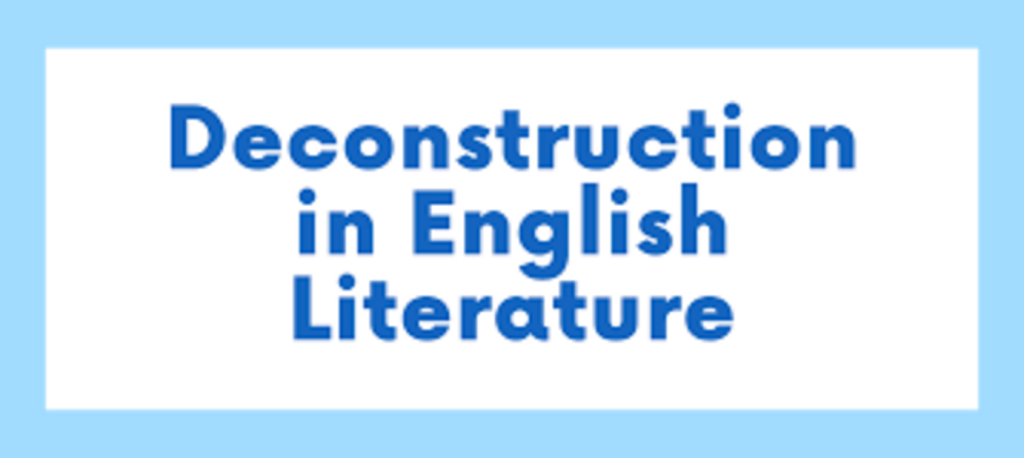JAKARTA, studyinca.ac.id – All right, so let’s dive into something that honestly scrambled my brain the first few times I dug into it: Deconstruction. If you’ve ever squinted at a book, a tweet, or even a WhatsApp chat and felt like, “Wait, am I missing something here?”, then buddy, deconstruction is about to become your new favorite mind game.
What Exactly Is Deconstruction?

Okay, so deconstruction isn’t about tearing your assignments apart when you’re stressed (though I’ve been there!). It’s this deep, philosophical way of reading texts—thanks to Jacques Derrida—that basically says: There’s no single real meaning in a text. Honestly, that sounded super weird to me at first. Like, aren’t words just… you know, words?
I used to take stuff way too literally. If an author said “The rain fell hard,” I just pictured some heavy rain. But turn out, with deconstruction, you’re supposed to look at all the hidden layers behind that phrase—stuff like cultural background, word choice, even what the author left unsaid. One text, infinite interpretations. Kind of wild.
How I Learned to Doubt Everything I Read
Here’s where it got personal for me. Back in college, I wrote this essay on a classic Indonesian short story. I dropped all these facts, stuck to the plot, no frills. Got a pretty average grade. Then my prof asked, “Why do you assume that’s the only meaning?” That comment haunted me!
Next time, I tried digging deeper—asking stuff like, “What if this isn’t just about rain, but about frustration or cleansing or even climate anxiety?” Suddenly, the story came alive. The more questions I asked, the more I realized: Knowledge isn’t set in stone, and meaning is always shifting. Mind blown.
Busting Common Deconstruction Myths (Learn From My Mistakes!)
Look, if you’re like me and you’ve ever thought deconstruction means “destroying” a text or making it meaningless, that’s a newbie trap. I made that mistake! I’d nitpick everything until my essays read like conspiracy theories. Turns out, deconstruction is about highlighting tension and ambiguity, not just chaos.
Another classic blunder: ignoring context. I used to focus way too much on the words, not the world around them. But if you want to play the deconstruction game right, you’ve got to ask: Who wrote this? For whom? When? All those details will change what you find in the subtext.
Cool Examples of Deconstruction In Real Life
Let’s make it real. Ever watched a Marvel movie and then read a fan theory that’s like, “What if Captain America was the villain all along?” That’s a form of deconstruction. You’re flipping the script on what the text seemed to say at first glance. I once did this with a Taylor Swift song, hunting for hidden meanings. Did I overthink? Sure. Was it awesome? Absolutely.
Or, think about news headlines—they’re often written to make you feel a certain way. Deconstruction helps you spot assumptions or biases hidden under those catchy titles. I’ve caught myself falling for clickbait more times than I’m proud to admit. Now, I pause and pick things apart before reacting. Super helpful skill!
Why Bother With Deconstruction? Here’s The Payoff
If you think this stuff sounds tiring, stick with me. Deconstruction can level up your brain like nothing else. For one, it’ll make you a way better critical thinker, which is pure gold these days.
Research backs this up—students exposed to deconstruction techniques score higher in tasks analyzing text ambiguity and bias (Smith et al, 2022). You’ll start noticing things like, “Is this ad subtly telling me I’m not enough if I don’t buy this cream?” Or, “Why does this policy document use such fancy language? What are they hiding?” Even my friends laugh about how I always spot the catch in an agreement, but hey, I save us from some shady deals. Win!
Quick Tips to Start Challenging Textual Meaning (Without Losing It)
- Always ask yourself: What is the author NOT saying?
- Flip the main idea. Can the opposite also be true?
- Look for contradictions—words or ideas that don’t quite line up.
- Never read alone! Chat with friends. My group WhatsApp threads have exposed wild interpretations.
- Read against the grain—if everyone agrees on the message, see what happens when you question it.
Trust me, you don’t have to be an academic to do this. One time, my mom deconstructed a soap opera script at dinner. We all had a good laugh—and weirdly deep conversation!
Big Lessons & Why It’s Worth Embracing Ambiguity
So, here’s my biggest takeaway after years of deconstructing everything from poetry to political speeches: Life and language are messy. There’s freedom in realizing that you’re not wrong just because you see things differently.
I feel far more confident speaking up, offering unusual takes, and not being afraid to ask, “But what if…?” Sure, sometimes it gets awkward (especially when you challenge a professor), but that’s part of growth.
If you jump into this, be patient. I used to get frustrated not finding a clear answer. Now, I see that living in the “gray areas” is where most of our best insights, empathy, and creative thinking come from.
Ready to Deconstruct Your World?
Next time you read literally anything—a tweet, a law, a song lyric—remember, the surface is just one starting point. Deconstruction isn’t about being cynical; it’s about being curious and just a little rebellious. And hey, in a world full of assumptions, maybe that’s exactly what we need.
If you ever find a mind-bending interpretation you want to rant about, drop it in the comments below. Let’s challenge some meanings together!
Read also about Hospital Training to learn how medical staff are equipped with essential skills, clinical knowledge, and hands-on experience to deliver high-quality patient care.

